 Flint Tools
Flint Tools
Wed Jan 24, 2024 2:19 pm
Welcome to the "Flint Tools" area of our forum, a dedicated space within our Portable Rock Art community! Here, we focus on showcasing and discussing flint tools that are not only functional but also possess an artistic or figurative aspect. This forum is the perfect place for enthusiasts, experts, and amateurs alike who appreciate the dual nature of these ancient artifacts.
What to Post:
Archetypal Flint Tools: We're looking for flint tools that are classic examples of their type, with clear and recognizable forms.
Evidence of Blade Retouch: Each submission should exhibit traditional signs of retouching or other clear signs, indicating the craftsmanship involved in creating these tools.
Artistic and Figurative Elements: We are particularly interested in flint tools that go beyond mere functionality. Does your flint tool bear resemblance to an animal, human form, or perhaps an abstract artistic design? Share it here!
Educational Insights: Accompany your posts with information about the tool's origin, it's suggested usage, estimated age, and the process used in its creation, if known.
Guidelines:
Stay On Topic: Ensure your posts and discussions are relevant to the artistic and archetypal nature of flint tools.
Quality over Quantity: We prioritize well-documented, clear, and informative posts. Low-effort submissions may be removed.
Respectful Interaction: Engage with fellow community members respectfully. We encourage healthy discussions and debates.
Authenticity: Share genuine artifacts only. Reproductions or modern creations should be clearly labelled as such.
Moderation:
Posts that do not meet the criteria will be reviewed and may be removed to maintain the forum's focus and quality.
Repeat offenders may face temporary or permanent restrictions.
We're excited to see your contributions and learn together about the fascinating world of flint tools that bridge the gap between utility and art. Let's delve into the history and beauty of these ancient artifacts!
What to Post:
Archetypal Flint Tools: We're looking for flint tools that are classic examples of their type, with clear and recognizable forms.
Evidence of Blade Retouch: Each submission should exhibit traditional signs of retouching or other clear signs, indicating the craftsmanship involved in creating these tools.
Artistic and Figurative Elements: We are particularly interested in flint tools that go beyond mere functionality. Does your flint tool bear resemblance to an animal, human form, or perhaps an abstract artistic design? Share it here!
Educational Insights: Accompany your posts with information about the tool's origin, it's suggested usage, estimated age, and the process used in its creation, if known.
Guidelines:
Stay On Topic: Ensure your posts and discussions are relevant to the artistic and archetypal nature of flint tools.
Quality over Quantity: We prioritize well-documented, clear, and informative posts. Low-effort submissions may be removed.
Respectful Interaction: Engage with fellow community members respectfully. We encourage healthy discussions and debates.
Authenticity: Share genuine artifacts only. Reproductions or modern creations should be clearly labelled as such.
Moderation:
Posts that do not meet the criteria will be reviewed and may be removed to maintain the forum's focus and quality.
Repeat offenders may face temporary or permanent restrictions.
We're excited to see your contributions and learn together about the fascinating world of flint tools that bridge the gap between utility and art. Let's delve into the history and beauty of these ancient artifacts!
 Re: Flint Tools
Re: Flint Tools
Wed Jan 24, 2024 2:39 pm
Welcome to my first post in the "Flint Tools" forum! Today, I'm excited to showcase a fascinating piece from a very old assemblage from a new location – the Bison Flint Tool. This artifact is not just a testament to the skilled craftsmanship of our ancestors but also a playful example of prehistoric humour. Flint artifacts of this colour and location are often described as being Middle Palaeolithic in origin,.
About the Bison Flint Tool:
Description: This prehistoric flint carving depicts a bison, notable for its absence of legs. The bison's lower body transitions into a serrated edge, resembling a blade, other figurative elements are also seen including an ape face or three, and even a kind of gnome face profile complete with hat and pigment eye.
Artistic Element: The most intriguing aspect of this tool is the clever visual pun it presents. The legless bison is paired with a blood coloured pigment along its serrated 'blade' edge. This design whimsically suggests that the bison's legs were 'cut off' by the very tool it forms.
The Visual Joke: This piece offers a unique blend of visual storytelling and humour. The absence of legs, combined with the red pigment on the serrated edge, playfully hints at an ancient joke – a visual oxymoron where the bison cannot have its legs cut off by a part of itself. It's a thought-provoking play on the idea of the tool and the carved figure being one and the same, but the joke goes deeper than that, just like modern jokes its a play on duality, not of words here but in visuals.
Discussion Points:
What do you think about the dual nature of this tool – both as a practical object and as a piece of art?
How do you interpret the humour behind this prehistoric artifact?
Can you share similar artifacts that blend utility with a sense of playfulness or artistic expression?
This post aims to spark a conversation about the intricate relationship between functionality and artistry in ancient flint tools. We look forward to reading your insights and learning about any similar pieces you might have encountered!
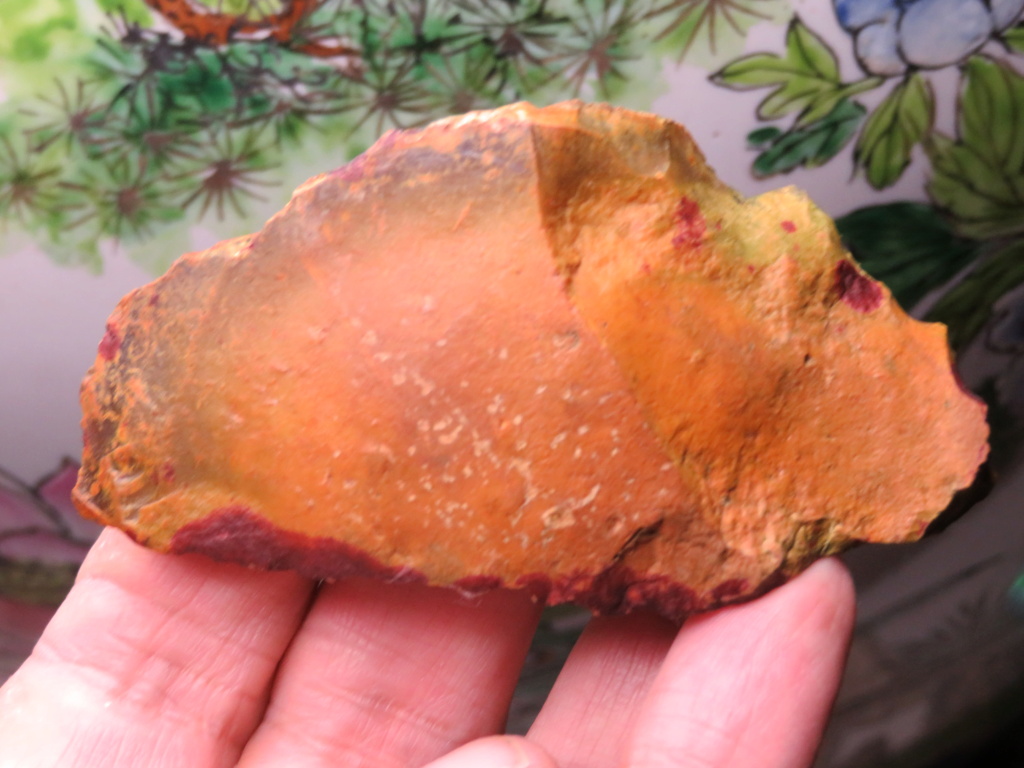
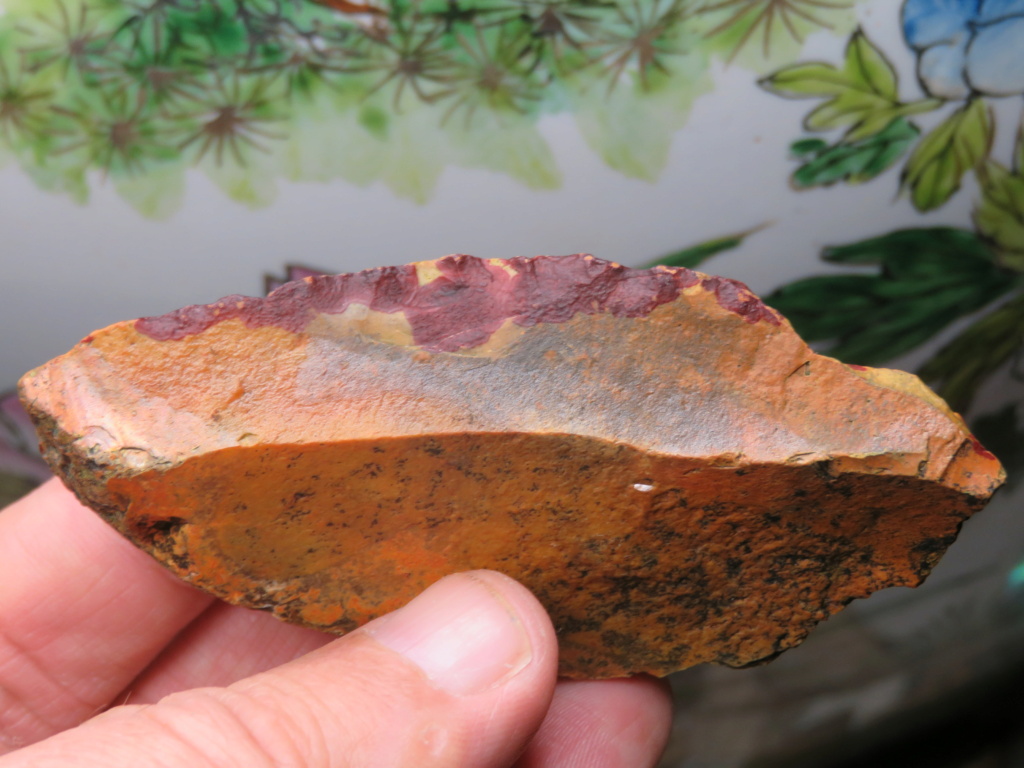
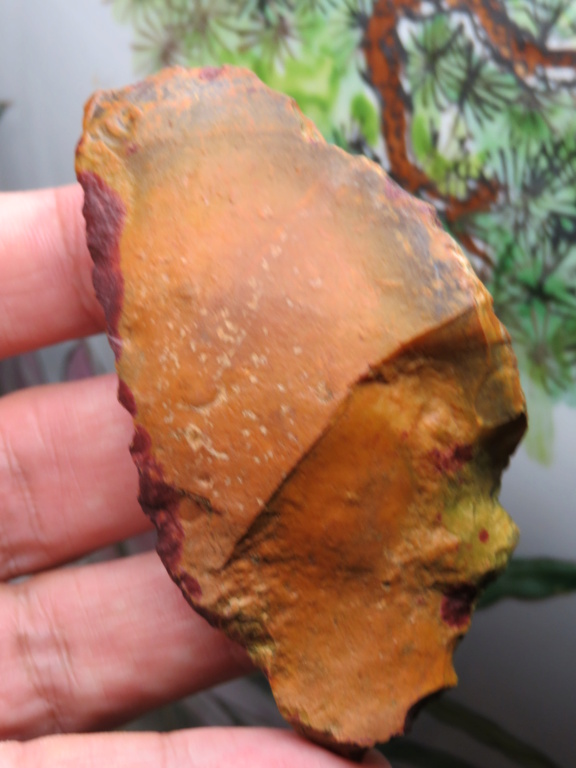

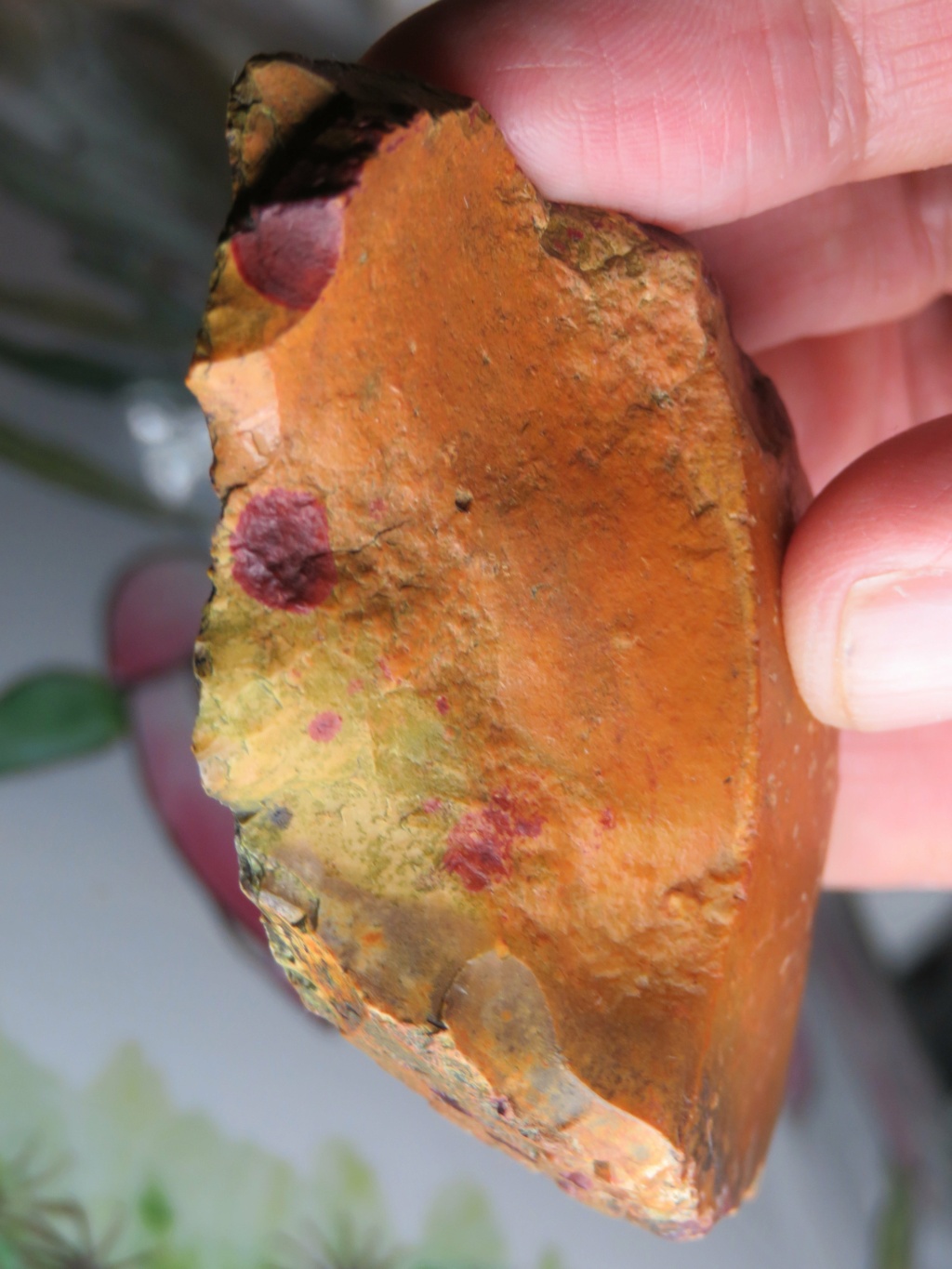

About the Bison Flint Tool:
Description: This prehistoric flint carving depicts a bison, notable for its absence of legs. The bison's lower body transitions into a serrated edge, resembling a blade, other figurative elements are also seen including an ape face or three, and even a kind of gnome face profile complete with hat and pigment eye.
Artistic Element: The most intriguing aspect of this tool is the clever visual pun it presents. The legless bison is paired with a blood coloured pigment along its serrated 'blade' edge. This design whimsically suggests that the bison's legs were 'cut off' by the very tool it forms.
The Visual Joke: This piece offers a unique blend of visual storytelling and humour. The absence of legs, combined with the red pigment on the serrated edge, playfully hints at an ancient joke – a visual oxymoron where the bison cannot have its legs cut off by a part of itself. It's a thought-provoking play on the idea of the tool and the carved figure being one and the same, but the joke goes deeper than that, just like modern jokes its a play on duality, not of words here but in visuals.
Discussion Points:
What do you think about the dual nature of this tool – both as a practical object and as a piece of art?
How do you interpret the humour behind this prehistoric artifact?
Can you share similar artifacts that blend utility with a sense of playfulness or artistic expression?
This post aims to spark a conversation about the intricate relationship between functionality and artistry in ancient flint tools. We look forward to reading your insights and learning about any similar pieces you might have encountered!






 Flint Tool Tortoice Art
Flint Tool Tortoice Art
Wed Jan 31, 2024 7:10 am
In the fascinating realm of palaeoanthropology, a recent discovery within Southern United Kingdom has emerged as a subject of profound intrigue and scientific debate. This piece, a Palaeolithic scraper, seemingly shaped to resemble a tortoise shell, not only demonstrates the sophisticated craftsmanship of our ancestors but also presents a paradox that challenges our understanding of the ancient fauna and the accuracy of the fossil record. The likeness to the shell of a tortoise can not so easily be dismissed, and it stands along side other worked flint artifacts displaying tortoise descriptions.
The artifact, dating back to the Palaeolithic era, signifies a period where modern humans apparently began to exhibit complex behaviour, including intricate tool-making and artistic expression. The Palaeolithic era spans a vast time frame, starting from approximately 2.6 million years ago until about 50,000 years ago, depending which books you read. This scraper's meticulous design, mirroring a tortoise shell, is particularly perplexing given the sparse fossil record of tortoises in the region during this period.
In France, for instance, the youngest known occurrences of tortoise fossils, such as the Titanochelon perpiniana from the Pliocene (5.3 to 2.6 million years ago) and the Titanochelon species from the Miocene (23 to 5.3 million years ago), indicate a presence in the region. Similarly, in Germany, the Titanochelon schleichi from the Miocene, specifically around the Burdigalian/Langhian boundary (20.4 to 13.82 million years ago), marks their existence. The youngest tortoise fossil found in the UK dates back to the Lower Cretaceous period, approximately 127 million years ago.
These findings illustrate a broader European context where tortoises were present, albeit in varying frequencies and distributions. The UK, however, presents a more ambiguous picture. The lack of substantial fossil evidence of tortoises during the Palaeolithic era in the UK raises questions about the origins of the knowledge necessary to create such a detailed and accurate representation of a tortoise shell.
One hypothesis for this anomaly involves Doggerland, a submerged landmass that once connected Britain to mainland Europe. This land bridge could have facilitated the migration of species, including tortoises, from areas with known populations, such as France and Germany, to the UK. However, this theory still leaves gaps in our understanding of how such detailed knowledge of tortoises was acquired, given their apparent rarity in the region. They could have been traded, as a form of commodity, is another possibility.
The discovery of the tortoise shell scraper, therefore, not only enriches our understanding of Palaeolithic craftsmanship but also challenges the prevailing narrative of the fossil record and species distribution during this time. It begs the question: could there be more to the story of tortoises in ancient Britain than the fossil record currently reveals?
The fossil record, while essential for understanding aspects of evolutionary history, is not an infallible indicator of human evolution. This is partly due to its nature of being incomplete and open to interpretation. The principle that the absence of evidence is not evidence of absence is particularly pertinent here. Artistic representations, such as those in my study, challenge traditional perspectives and underscore the potential gaps and biases in the fossil record, calling into question its status as the sole arbiter of human lineage. The reliance on fossils as the primary evidence for human evolution, which is a fundamental aspect of the scientific narrative, may be overly simplistic. This approach fails to acknowledge the complexities and potential nuances that other forms of evidence, like art, can bring to our understanding of human history. Simply put, basing the human evolution narrative on fossils, which is basically the crux of the 'science', is dumb.
The discovery of the Palaeolithic tortoise shell scraper necessitates a reevaluation of the fossil record, highlighting its limitations in fully capturing the complexities of ancient ecosystems and human interactions. This artifact, presenting a contrast with the known fossil record, emphasizes the need for integrating other forms of evidence, like lithic artifacts, in our study of human history. Such integration could provide a more nuanced understanding of our past, addressing the gaps and assumptions often inherent in archaeological research. This approach underscores the value of diverse evidence in piecing together the intricate puzzle of our ancestral legacy.

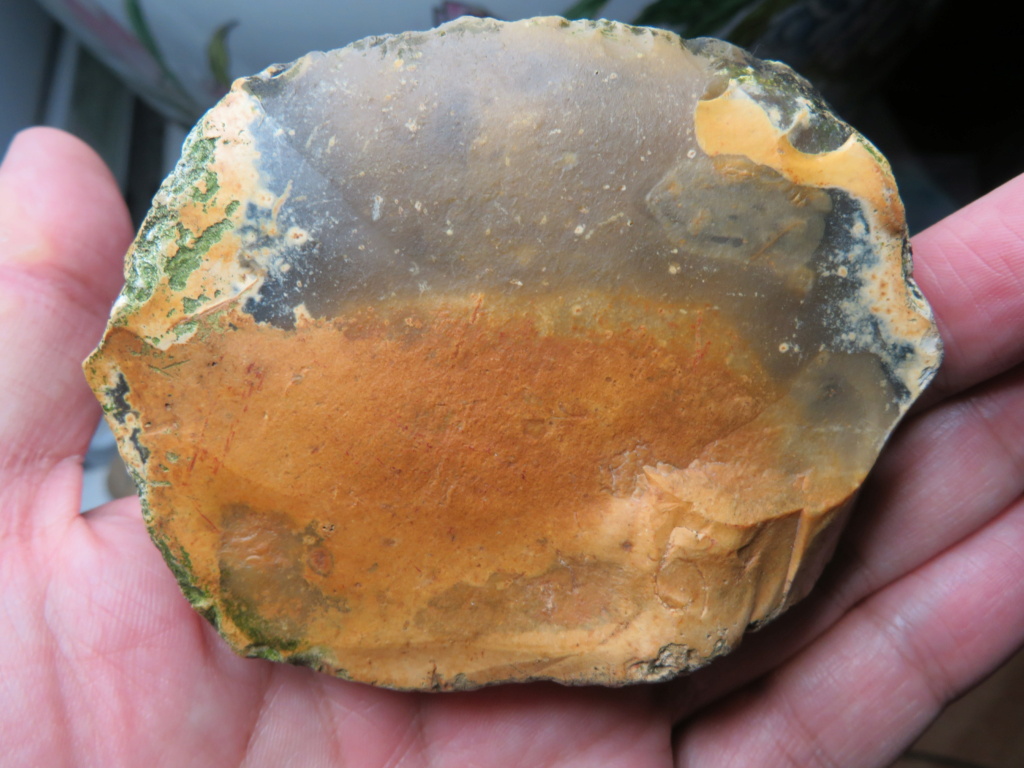


The artifact, dating back to the Palaeolithic era, signifies a period where modern humans apparently began to exhibit complex behaviour, including intricate tool-making and artistic expression. The Palaeolithic era spans a vast time frame, starting from approximately 2.6 million years ago until about 50,000 years ago, depending which books you read. This scraper's meticulous design, mirroring a tortoise shell, is particularly perplexing given the sparse fossil record of tortoises in the region during this period.
In France, for instance, the youngest known occurrences of tortoise fossils, such as the Titanochelon perpiniana from the Pliocene (5.3 to 2.6 million years ago) and the Titanochelon species from the Miocene (23 to 5.3 million years ago), indicate a presence in the region. Similarly, in Germany, the Titanochelon schleichi from the Miocene, specifically around the Burdigalian/Langhian boundary (20.4 to 13.82 million years ago), marks their existence. The youngest tortoise fossil found in the UK dates back to the Lower Cretaceous period, approximately 127 million years ago.
These findings illustrate a broader European context where tortoises were present, albeit in varying frequencies and distributions. The UK, however, presents a more ambiguous picture. The lack of substantial fossil evidence of tortoises during the Palaeolithic era in the UK raises questions about the origins of the knowledge necessary to create such a detailed and accurate representation of a tortoise shell.
One hypothesis for this anomaly involves Doggerland, a submerged landmass that once connected Britain to mainland Europe. This land bridge could have facilitated the migration of species, including tortoises, from areas with known populations, such as France and Germany, to the UK. However, this theory still leaves gaps in our understanding of how such detailed knowledge of tortoises was acquired, given their apparent rarity in the region. They could have been traded, as a form of commodity, is another possibility.
The discovery of the tortoise shell scraper, therefore, not only enriches our understanding of Palaeolithic craftsmanship but also challenges the prevailing narrative of the fossil record and species distribution during this time. It begs the question: could there be more to the story of tortoises in ancient Britain than the fossil record currently reveals?
The fossil record, while essential for understanding aspects of evolutionary history, is not an infallible indicator of human evolution. This is partly due to its nature of being incomplete and open to interpretation. The principle that the absence of evidence is not evidence of absence is particularly pertinent here. Artistic representations, such as those in my study, challenge traditional perspectives and underscore the potential gaps and biases in the fossil record, calling into question its status as the sole arbiter of human lineage. The reliance on fossils as the primary evidence for human evolution, which is a fundamental aspect of the scientific narrative, may be overly simplistic. This approach fails to acknowledge the complexities and potential nuances that other forms of evidence, like art, can bring to our understanding of human history. Simply put, basing the human evolution narrative on fossils, which is basically the crux of the 'science', is dumb.
The discovery of the Palaeolithic tortoise shell scraper necessitates a reevaluation of the fossil record, highlighting its limitations in fully capturing the complexities of ancient ecosystems and human interactions. This artifact, presenting a contrast with the known fossil record, emphasizes the need for integrating other forms of evidence, like lithic artifacts, in our study of human history. Such integration could provide a more nuanced understanding of our past, addressing the gaps and assumptions often inherent in archaeological research. This approach underscores the value of diverse evidence in piecing together the intricate puzzle of our ancestral legacy.




amytaylorlangston@gmail.c likes this post
 Re: Flint Tools
Re: Flint Tools
Fri Feb 16, 2024 8:35 am
amytaylorlangston@gmail.c wrote:It seems logical that we should expect to find artifacts depicting tortoise shell. After all it was a food source that once acquired it could be 'stored' for future use when no other meat could be obtain. Simply by turning it over....no refrigeration needed. No prep needed in the storage of it even. It could be left for months upside down until ready to be eaten. So I would think it could represent a significant aspect insomuch as the part it played in thierl ife just as the depictions of other sources of protein are seen. Of course this is all just what I personally am thinking on the subject you know. Why would we NOT see it?
Thanks Amy for sharing your thoughts. You raise a compelling point about the functional importance of tortoises as a sustainable food source, reminiscent of historical practices where sailors during the 1500-1800s would keep tortoises aboard ships as a means of storing fresh meat and water. Your analogy draws a possible parallel with potential Palaeolithic practices, emphasizing the tortoise's utility in past times. What I find shocking is we lack direct paleontological evidence of their presence in the UK during the Palaeolithic era, apart from my figurative lithic finds. This contrast between tangible art pieces and the absence of fossil records indeed adds mystery to our understanding of early human life and their interaction with the environment, lacking evidence of tortoise from fossils and other remains casts very serious doubt on the validity of using the fossil record to infer absence of any species in past times, homo-sapiens, dinosaurs, gorillas and basically whatever.
 amytaylorlangston@gmail.c
amytaylorlangston@gmail.c- Posts : 377
Join date : 2020-11-03
Age : 54
Location : Ok/Tx
 Re: Flint Tools
Re: Flint Tools
Fri Feb 16, 2024 10:00 am
Yes just as it goes that just because you don't see it doesn't mean it isnt there. Assumptions can be made as long as it's an opinionated assumption....not one that that is said to be taken to infer because of THIS...we get THIS and that it's a fact. I think that practice is a lot of guessing and wishing and hoping etc instead of using deductive reasoning to state ur opinion only. I sorta think maybe all them scientists have revealed in these new discoveries of bones etc that they have maybe gotten away with themselves. You know what I mean? For example the whole business over clovis. Boy you couldn't tell some of them a single thing contrary to what they thought about clovis.ans now we have much evidence in proff they were wrong. And now over the star cave system......well that's got some assumptions going on. The fact still is that we just don't know for sure until we actually know from empirical evidence.
It's funny though ...even when the evidence if such(rock art) is smack dab in thier face thier blind as bats! Go figure that one.
It's funny though ...even when the evidence if such(rock art) is smack dab in thier face thier blind as bats! Go figure that one.
Brett likes this post
 Palaeolithic Flint Tool
Palaeolithic Flint Tool
Sun Feb 18, 2024 9:46 am
This Palaeolithic flint tool exhibits unmistakable signs of deliberate design, with a wedge shape crafted through minimal yet precise large long slender flake removals. It bears the hallmarks of cognitive foresight, evidenced by numerous small retouches that not only enhance its utility but also add to its figurative representation. The tool portrays some of the most common animal depictions in profile including a bear, an elephant, an ape, and a feline, each meticulously shaped to convey their distinct features. Additionally, there's an ape with a winking face, adding a whimsical element to the tool. Certain depictions even include detailed pupils, lending credence to the intentional nature of these figurative carvings.
The hand-axe displays the hall marks of being a multi-tool, useful for digging, stabbing, foliage stripping, cutting, and as a visual communication tool.
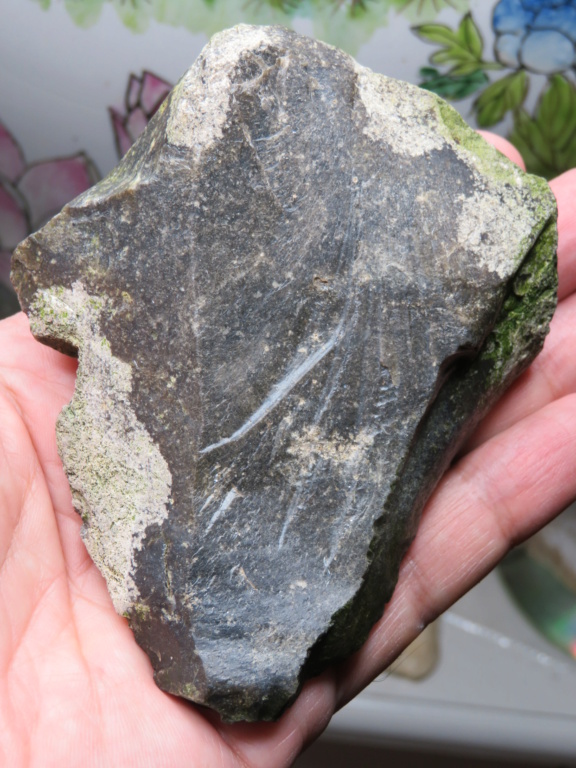



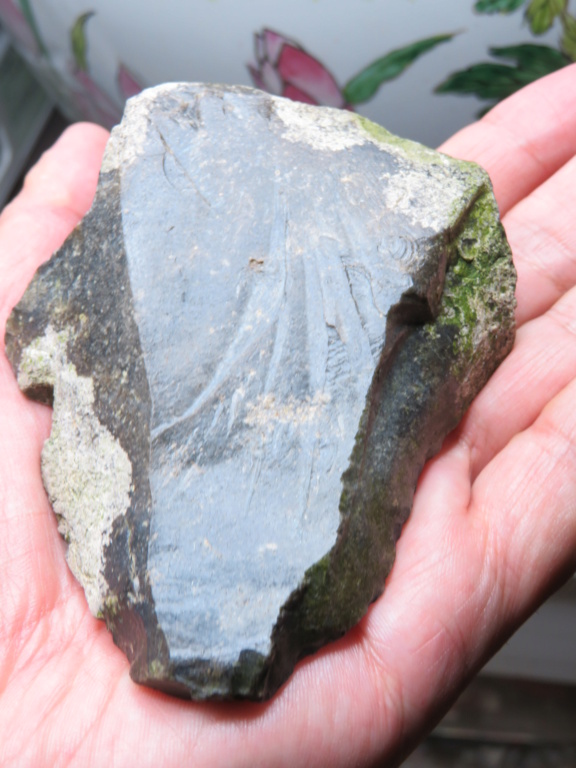
The hand-axe displays the hall marks of being a multi-tool, useful for digging, stabbing, foliage stripping, cutting, and as a visual communication tool.





amytaylorlangston@gmail.c likes this post
 Re: Flint Tools
Re: Flint Tools
Thu Feb 22, 2024 10:13 am
Here's another intriguing flint tool from the same site that has yielded all the artifacts discussed in this forum thread. This tool, believed to be from the Palaeolithic era, features distinct figurative elements and has been retouched to enhance its sharpness and to highlight a prominent human image. I'm increasingly convinced that this location is an ancient Palaeolithic surface, given the abundance and variety of flint finds here.
Many of the discovered artifacts share common traits: several are clearly blades or scrapers, some bear figurations, and a number of them have a deep ox blood coloured pigment. The black flint pieces display a mottled, patchy brown patina. Some of these finds are quite large, including two substantial flint scrapers and a 23cm hand axe. A notable feature of many tools is the presence of crystalline areas.
The blade/scraper featured in the photos embodies all these characteristics. The creation of this tool raises an interesting question about the skill involved in flint knapping. Is it more skilful to shape a flint by striking it multiple times to remove flakes and achieve the desired form, or does greater skill lie in the ability to envisage the final form and achieve it with a single, well-placed strike? I lean towards the latter, though it's evident from this specimen that, despite the primary shaping being achieved with one strike, numerous additional tiny flake removals were necessary for sharpening the blade and refining the human face profile. The find has a small polished area on the reverse, where some flakes were removed, the polishing caused by extensive use in the hand over many years is logical.
As many enthusiasts of rock art know, pareidolia can often mislead, but the detailing in this artifact — the nostril, chin, the oval eye, and the minute detailing of the eyeball and pupil (highlighted in the photo) — clearly indicates intentional design. This tool is not just a product of natural rock formations but a result of deliberate human craftsmanship.
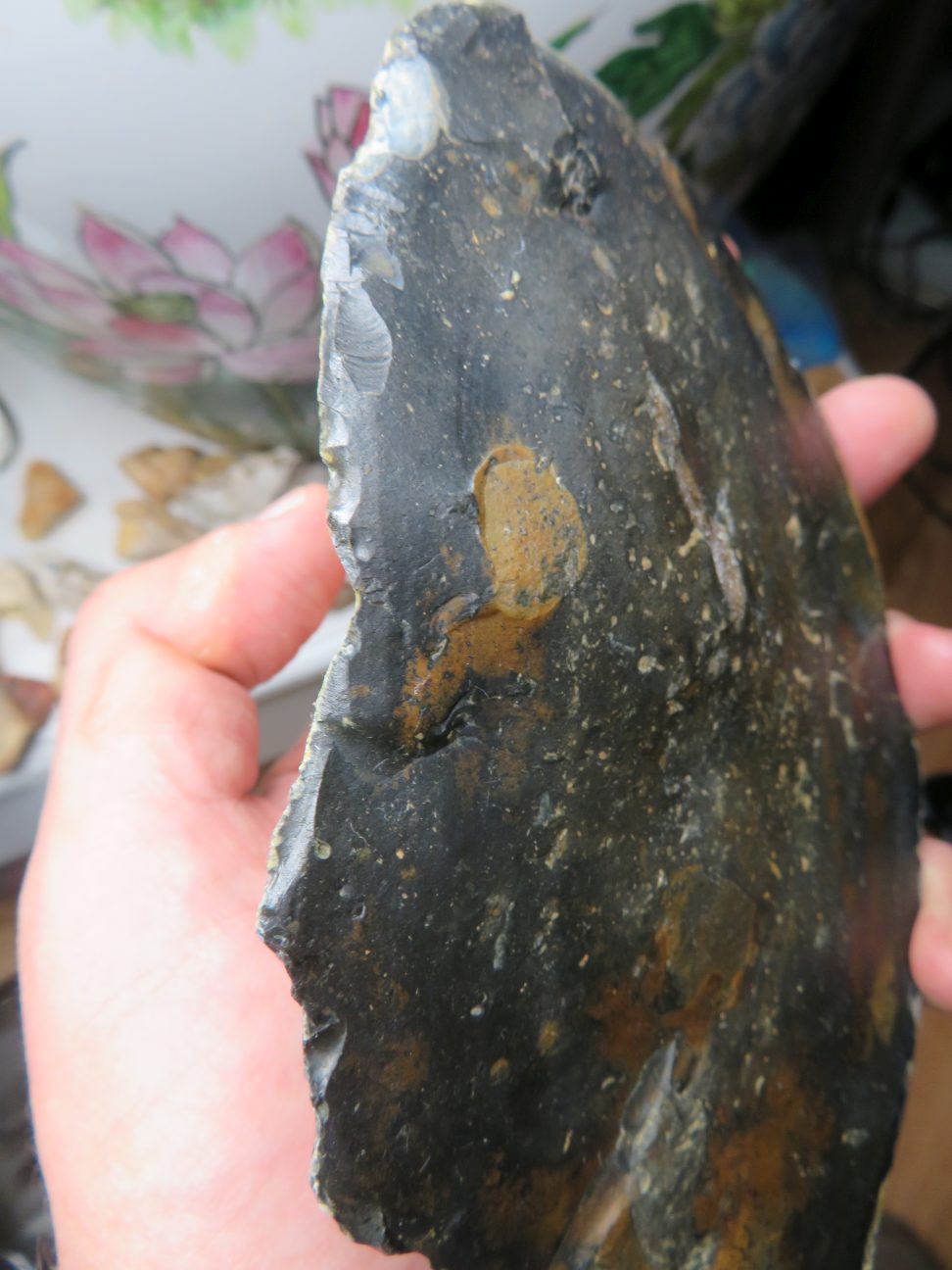



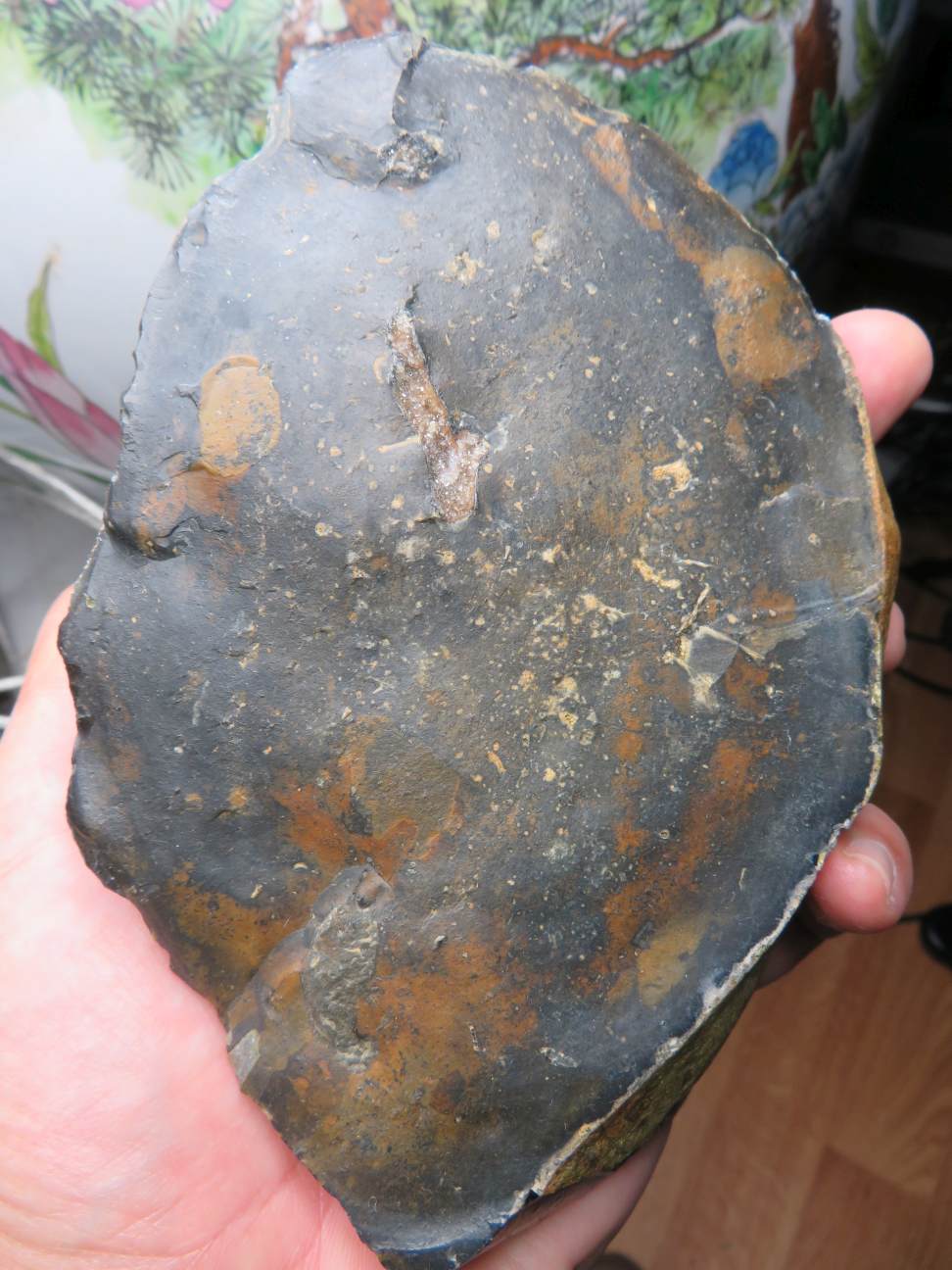
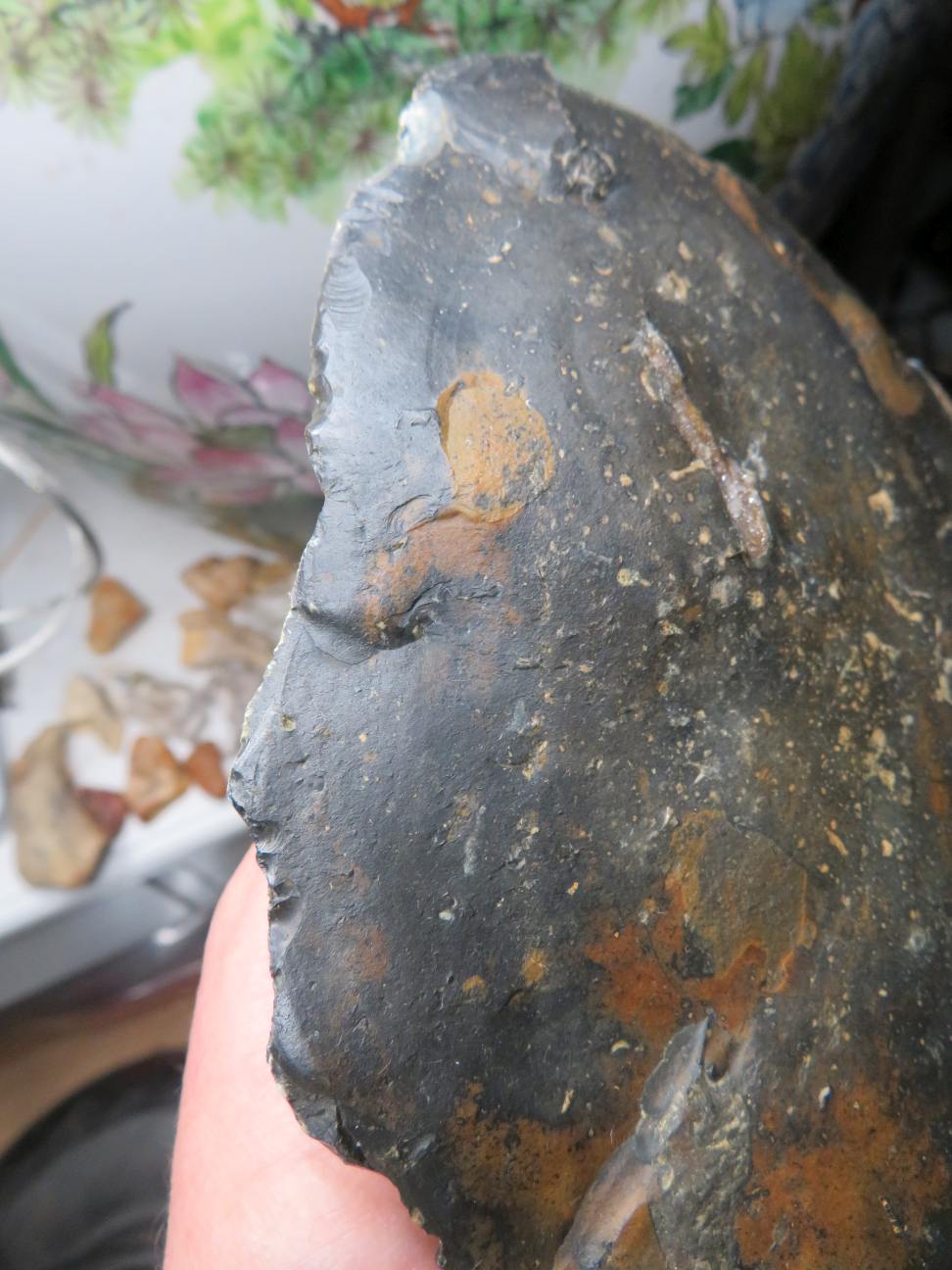
Many of the discovered artifacts share common traits: several are clearly blades or scrapers, some bear figurations, and a number of them have a deep ox blood coloured pigment. The black flint pieces display a mottled, patchy brown patina. Some of these finds are quite large, including two substantial flint scrapers and a 23cm hand axe. A notable feature of many tools is the presence of crystalline areas.
The blade/scraper featured in the photos embodies all these characteristics. The creation of this tool raises an interesting question about the skill involved in flint knapping. Is it more skilful to shape a flint by striking it multiple times to remove flakes and achieve the desired form, or does greater skill lie in the ability to envisage the final form and achieve it with a single, well-placed strike? I lean towards the latter, though it's evident from this specimen that, despite the primary shaping being achieved with one strike, numerous additional tiny flake removals were necessary for sharpening the blade and refining the human face profile. The find has a small polished area on the reverse, where some flakes were removed, the polishing caused by extensive use in the hand over many years is logical.
As many enthusiasts of rock art know, pareidolia can often mislead, but the detailing in this artifact — the nostril, chin, the oval eye, and the minute detailing of the eyeball and pupil (highlighted in the photo) — clearly indicates intentional design. This tool is not just a product of natural rock formations but a result of deliberate human craftsmanship.






amytaylorlangston@gmail.c likes this post
 John
John- Posts : 29
Join date : 2023-07-12
 Re: Flint Tools
Re: Flint Tools
Mon Mar 04, 2024 5:31 pm
That's a woman. Absolutely feminine face.
Seems quite a rare find to me ?
Awesome.
Seems quite a rare find to me ?
Awesome.
Permissions in this forum:
You cannot reply to topics in this forum|
|
|


